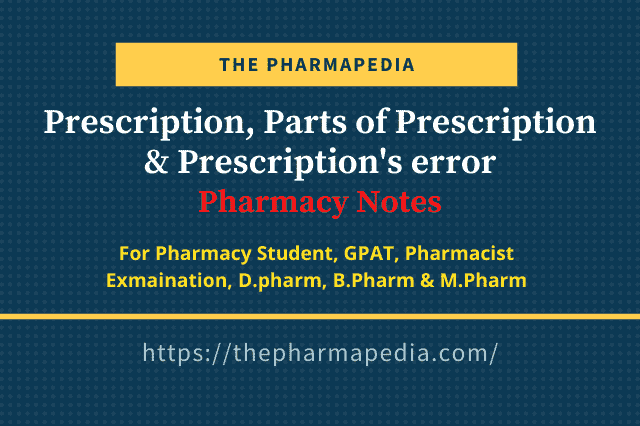What is a Prescription
A prescription is a written order from a registered medical practitioner to a pharmacist to compound and dispense medication for a patient.
- Prescription
- Contain direction for the pharmacist to prepare and compound for specific type of medication preparations
- Contains direction for the patient regarding mode of administration of drug
- Written in English language
- Latin words/abbreviations used sometime
Or you can say prescription is a media through which treatment is provided to the patient by combining skill & services of both registered pharmacist and registered physician.
There are two broad legal classifications of medications:
- The medications which can be obtained only by prescription which are referred as prescription drugs or legend drugs.
- The medications which may be purchased without a prescription, which are termed non prescription drugs or over-the-counter (OTC).
Part of prescription
1. Date
Date is important in the case of narcotics and habit-forming drugs to avoid the misuse of prescription.
2. Patient details (Name, age, sex, address)
Help to identify the prescription and also help to check the prescribed dose of medication.
3. Superscription
- Represented by symbol Rx/℞ mean “you take” or “take thou”
- Written before prescription
- Symbol of God of healing Jupiter
4. Inscription
- Main part of the prescription
- Contains name and quantities of prescribed medications
- It has 3 part
- Base
- Adjuvant and
- Vehicle
5. Subscription
Direction for the pharmacist regarding medication and number of doses to be dispensed
6. Signatura/Signa/transcription
- Direction/instruction for the patient regarding the administration of the drug.
- Instruction/directions are required to transfer to the Label of the container (how, when, how much etc)
7. Renewal/refilling instruction
Information about renewal if required
8. Signature, address, registration number of prescriber
A prescription must bear the signature of a prescriber along with the registered number and address.
Handling of the prescription by Pharmacist
For compounding and dispensing the prescription, the pharmacist should be followed the following procedure:-
- Receiving prescription
- Reading and checking prescription
- Collecting and weighting the material
- Compounding, labelling and packaging
1. Receiving a prescription
- The pharmacist should be received the prescription himself
- During receiving the prescription pharmacists should not change his/her facial expression to avoid a bad impression to the present that the pharmacist is confused after seeing the prescription.
2. Reading and checking the prescription
- To check/screen a prescription for proper format behind the counter.
- If any doubt regarding medication/direction pharmacist should consult to another Senior pharmacist or prescriber without knowing the patient.
3. Collecting and weighting the materials
- All the materials required for compounding the prescription should be collected on the left side of the balance. After weighting, the material should be kept right-hand side of the balance.
- Label of every ingredient and container should be read at least three times before weighting and after weighting to avoid an error.
4. Compounding, labelling and packaging
- All tasks to be carried out in a neat place.
- Only one prescription should be compound at one time.
- A compound according to the direction of the prescription prescriber.
- After compounding filled container must be labelled properly
Modern method of prescribing or new trend in prescribing
Nowadays, most of the drugs are available in the market as ready-made formulations, manufactured by various pharmaceutical companies so there is no need to compound and dispense the drug by the pharmacist.
So now in the present days, the role of the pharmacist is focused to provide advice regarding
- Mode of Administration
- Dosing schedule
- Drug interaction
- Adverse drug reaction
- Drug/ANTIBIOTIC resistance/rational use of antibiotic
- Patient counselling
In prescription, the drug should be prescribed by its official generic name and not by its proprietary or trade name.
Type of prescriptions
1. Prescription in general practice
2. Private prescription
3. Hospital prescription mean for outpatient
4. Hospital prescription mean for inpatient
In addition, Prescriptions are also classified as following manners
1- Simple prescription:
Those written for a single component or prefabricated product and not requiring compounding or admixture by the pharmacist.
2- Compound or complex prescription:
Those written for more than a single component and requiring compounding.
3- e-prescriptions (electronic prescription):
The use of electronic means for the generation and transmission of prescriptions is used and accepted in some countries.
4- In-patient prescription:
A medication order form used in the hospital setting.
In addition, other forms may be used within a hospital by specialized units such as infectious disease, cardiac care, pediatrics, and others.
Source of error in prescription
Prescription errors are unintentional mistakes in the prescription, transcription, dispensing, and administration of medications. Some prescription errors include wrong patient, incorrect medication, inappropriate dose, wrong time, wrong route of administration, and wrong rate of administration
To prevent this, it is a good practice to follow the ‘‘five rights principle’’ as a check:
1. the right medication
2. in the right dose
3. to the right patients
4. at the right time
5. by the right route of administration
Major errors associated with prescription are listed below:-
I- Abbreviation
II- Name of drug
III- Strength of the preparation
IV- Dosage form of the drugs prescribed
V- Dose
VI- Instruction for the patient
VII- Incompatibility
COMPOUNDED & NON-COMPOUNDED PRESCRIPTION
Compounded Prescription
Compounding is the process of combining, mixing, or altering ingredients to create a medication tailored to the needs of a patient.
A compounded medication is a drug that is specifically mixed and prepared for you, based on a prescription from your doctor.
Compounding is most often practiced by a licensed pharmacist, a licensed physician, or a person under the supervision of a licensed pharmacist.
Read More…

